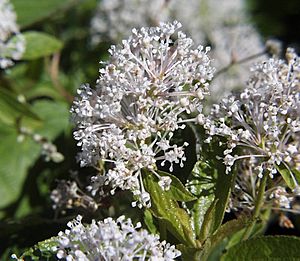New Jersey tea facts for kids
Quick facts for kids New Jersey tea |
|
|---|---|
 |
|
| Scientific classification | |
| Genus: |
Ceanothus
|
| Species: |
americanus
|
| Synonyms | |
The Ceanothus americanus is a type of shrub that grows naturally in North America. People often call it New Jersey tea. Other names include Jersey tea ceanothus, red root, mountain sweet, and wild snowball. The name "New Jersey tea" became popular during the American Revolution. This is because its leaves were used as a replacement for imported tea at that time.
Contents
What Does New Jersey Tea Look Like?
The New Jersey tea plant is a shrub that usually grows between 18 and 42 inches (about 0.5 to 1 meter) tall. It has many thin branches. Its root system is quite strong. It has small, thin root hairs near the surface. But it also has thick, woody roots that go deep into the ground. These deep roots help the plant survive, especially after wildfires.
The plant produces white flowers. These flowers grow in groups called inflorescences on long stems. After the flowers, the plant makes dry fruits. These fruits are seed capsules that open up to release their seeds.
Where Does New Jersey Tea Grow?
You can often find New Jersey tea in dry, open areas. These include plains, prairies, or other places without many trees. It prefers soil that is sandy or rocky. This plant also grows well in forest clearings, along the edges of forests, on banks, near lakeshores, and on gentle slopes.
Where Can You Find New Jersey Tea?
New Jersey tea is found in many places across North America.
- In Canada, it grows in Ontario and Quebec.
- In the U.S., it is found in many states. These include Alabama, Arkansas, Connecticut, Delaware, Florida (northern and central parts), Georgia, Illinois, Indiana, Iowa, Kansas, Louisiana, Maine (in Oxford and Penobscot counties), Maryland, Massachusetts, Michigan, Minnesota, Mississippi, Missouri, Nebraska, New Hampshire, New Jersey, New York, North and South Carolina, Ohio, Oklahoma, Pennsylvania, Rhode Island, Texas (eastern and central parts), Vermont, West Virginia, Wisconsin, and Virginia.
Who Uses This Plant?
Many animals and insects use the New Jersey tea plant.
- In winter, deer in the Ozarks of Missouri like to eat its twigs. White-tailed deer (Odocoileus virginianus) eat C. americanus all year long.
- The flowers are a food source for several types of butterflies. These include butterflies from the genus Celastrina, like the spring azure and summer azure. Other butterflies like Erynnis martialis (mottled duskywing) and Erynnis icelus (dreamy duskywing) also use the flowers. The shoots of the plant are also where these butterflies lay their eggs, and their larvae (caterpillars) grow there.
- Wild turkeys and quail eat the seeds of Ceanothus americanus.
Special Uses of New Jersey Tea
The red roots and root bark of the New Jersey tea plant have been used for a long time.
- North American Indians used them to help with infections in the upper breathing passages.
- Later, during the American Revolution, white settlers used the leaves as a substitute for regular tea. The leaves have a fresh smell, a bit like wintergreen, and make a stimulating drink that does not have caffeine.
- Today, some herbalists still use the root bark. It is especially used in remedies for problems with the lymph system, which is part of your body's immune system.
- The root contains natural substances called tannins and different types of peptide alkaloids. These include ceanothine A-E, pandamine, zizyphine, scutianine, and adouetines. These substances can have a mild effect that lowers blood pressure.
- Both the root and flower extracts can also be used to make dyes.
See also
 In Spanish: Ceanothus americanus para niños
In Spanish: Ceanothus americanus para niños

